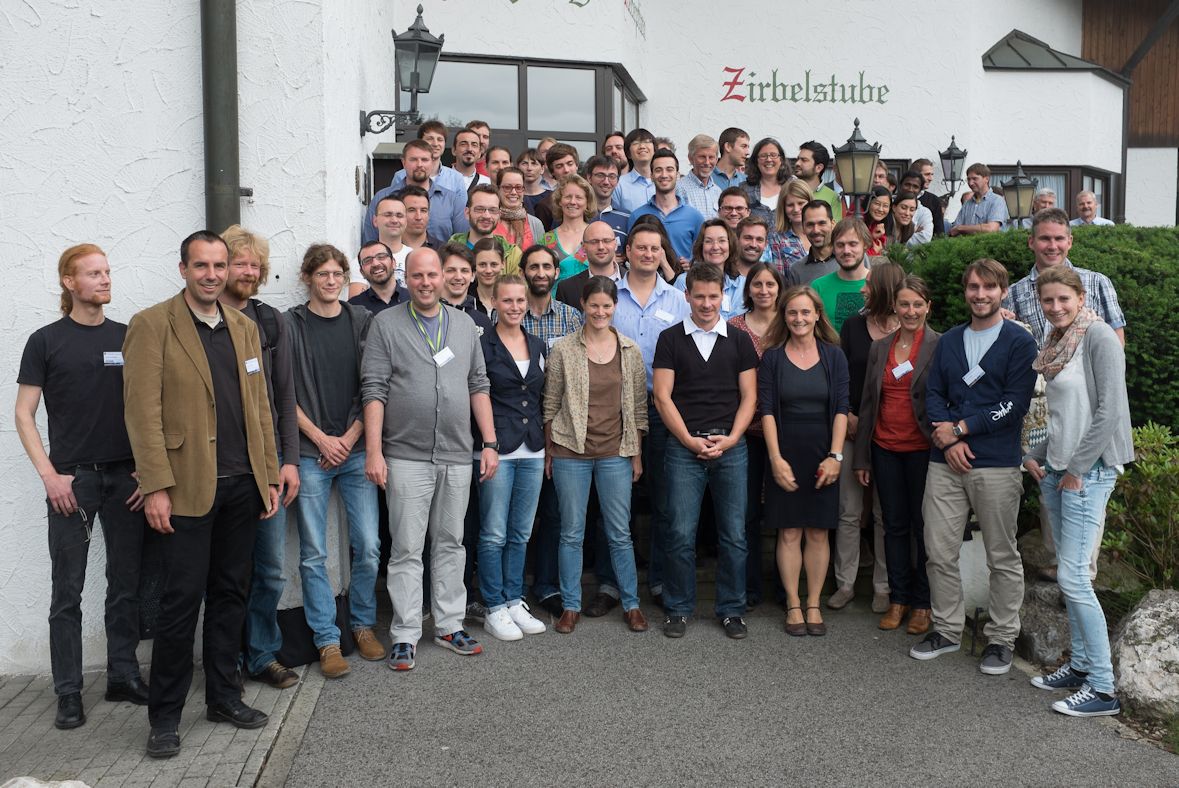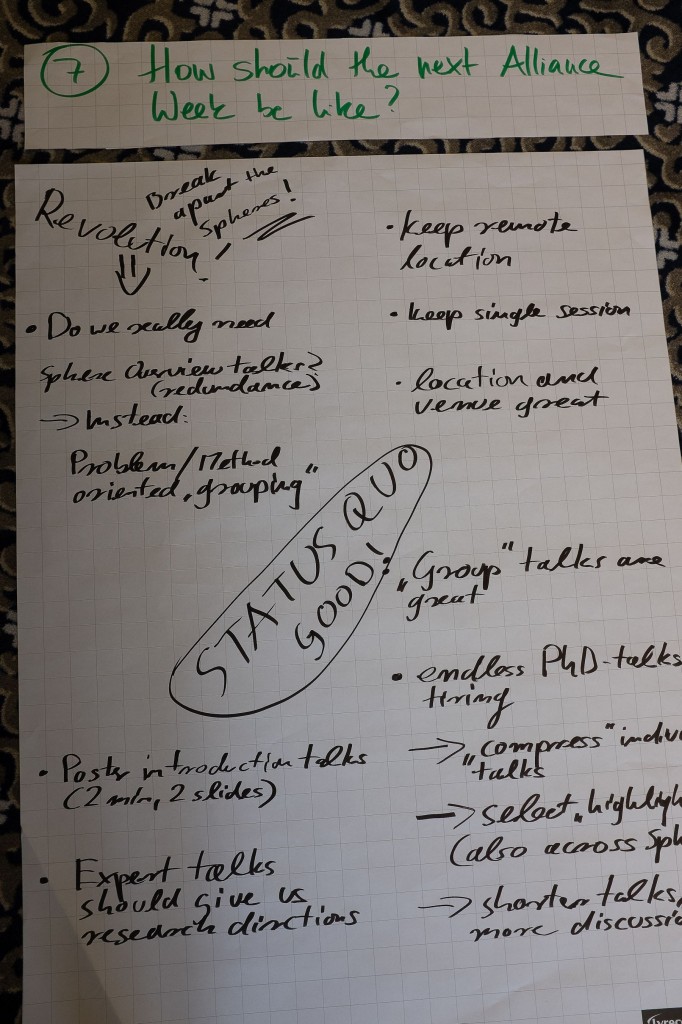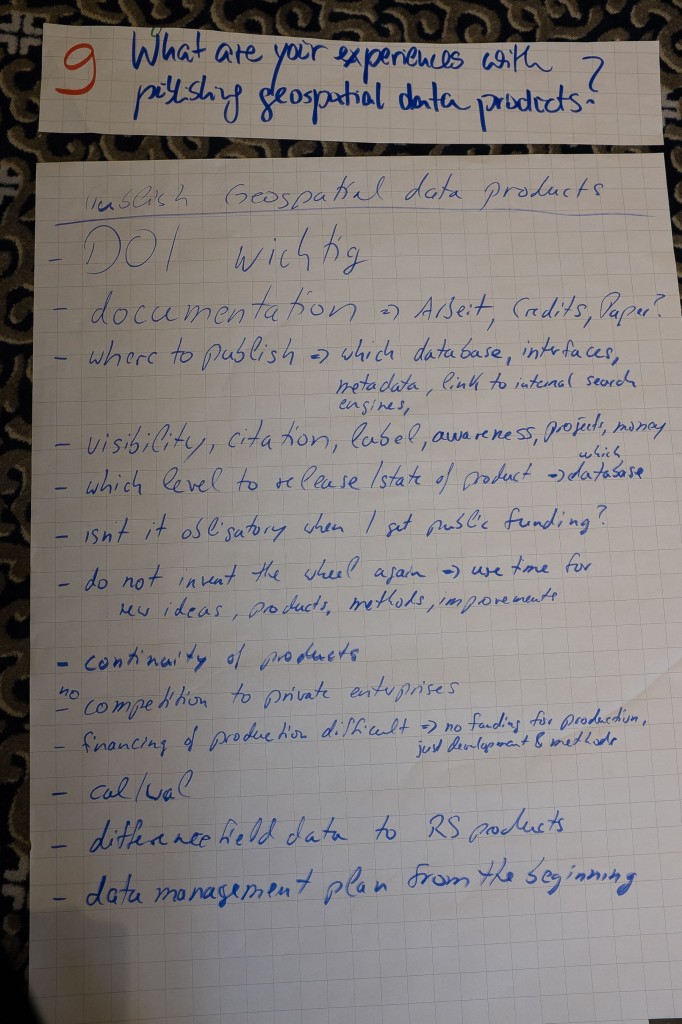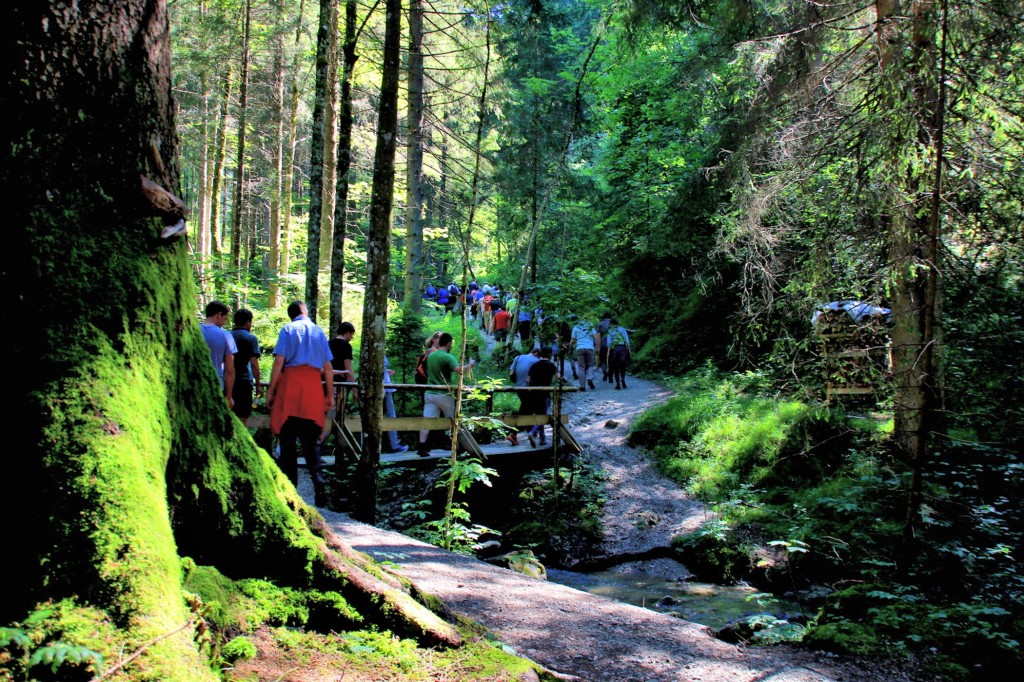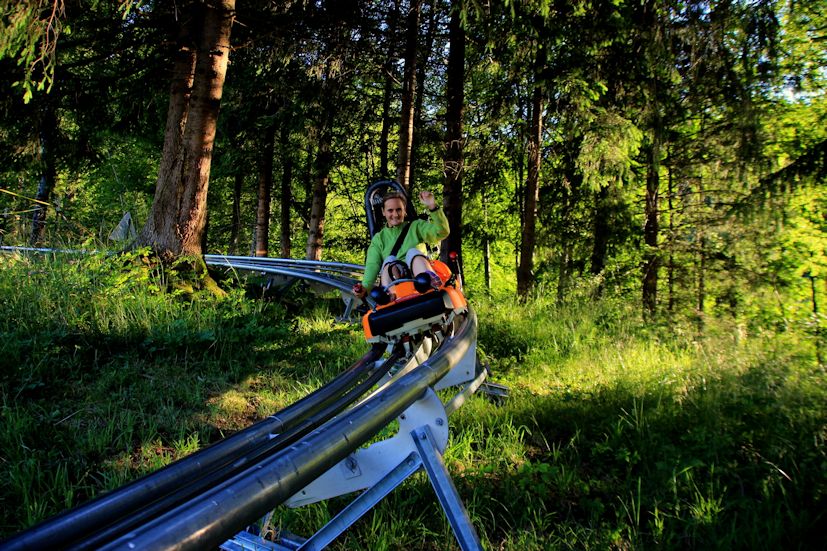Report of the 2nd Alliance Week: Remote Sensing and Earth System Dynamics”
We are delighted to report that our 2nd Alliance Week in Garmisch-Partenkirchen from 30th June to 4th July 2014 saw the successful completion of a wide range of activities. The workshop provided a great opportunity for diverse groups of interdisciplinary scientist to come together and discuss individual and programmatic aspects of the Earth Dynamics Alliance. All participants were afforded a deep insight into the ongoing scientific work of the different work packages. Furthermore, an emphasis of the meeting was laid on networking and discussions, as a means of enhancing the understanding between the different work packages of the different spheres, as well as to increase collaborations and form concrete recommendations for improving the project outcome. The findings of the workshop have wide-ranging implications for the scientific progress of the complete Earth Dynamics Alliance and will guide research efforts for the upcoming years.
Attendees of the 2nd Alliance Week in Garmisch-Partenkirchen
1st Day
The workshop began with the Young Scientists Day on Monday, June 30. This special day was one of the recommendations which emerged during the course of the “Young Scientists Discussion Forum” at the last Alliance Week 2013 and was established to stimulate scientific discussions and the exchange of experiences among young researchers from different spheres. To realize all of their innovative ideas, the Young Scientist Day was completely organized by the young researchers themselves. That’s why the agenda with items like “Poster Swapping”, “Why should Obama care” and “Open Space Conference” followed a less traditional format than the usual structure of most workshops. All in all the “Young Scientist Day” was a great success, with many innovative ideas and recommendations to foster the networking. For more information about the Young Scientist Day, see the article from Nicole Richter (PhD Student at GFZ).
2nd Day
The Young Scientists Day was followed by the official HGF Annual Meeting, which continued in the good spirit of the beginning. Principle Investigator Prof. Alberto Moreira commenced the Alliance Week for all remaining Alliance members and external experts by opening the Plenary Session. The first presentation was held by Prof. Irena Hajnsek, the Scientific Coordinator of the HGF Alliance, who impressed, once more, the project goals upon the team and informed the audience concerning the current project status. Compared to the previous year, notable progress was evident.
Following this introduction, Dr. Ake Rosenqvist (JAXA) gave an informative overview of JAXAS’s L-band SAR program. Especially the very first images and the acquisition potential of the new satellite ALOS II, which was launched in May 2014, were of special interest, in particular with regards to the future Tandem-L mission. Finally, Prof. Iain Woodhouse from the University of Edinburgh closed the Plenary Session with his “Vision for a Multiscale Operational Forest Monitoring Solution”. His main message, namely that it is of great importance to bring together research and users on-site, met with great approval in the audience.
Following this motivating start, the research topic speakers Prof. Andreas Huth (UFZ), Prof. Michael Eineder (DLR), Dr. Ute Wollschläger (UFZ) and Prof. Angelika Humbert (AWI) gave an overview of the ongoing activities in the research areas Biosphere, Geosphere, Hydrosphere and Cryosphere. It became clear that the work in all individual work packages had significantly progressed since the previous year. A major achievement in the cryosphere was, for example, the application of remote sensing derived ice flow velocity fields to the task of planning a logistically challenging airborne campaign that has acquired data to support the assessment of subglacial water. A further highlight in the Geosphere was the Chile field campaign, where scientist involved in different work packages and from three HGF centers (GFZ, GEOMAR and DLR) worked together.
With this wealth of information as a basis, the experts of the External Advisory Board and the User Board commenced their internal group meetings to form recommendations with regards to improving the project awareness level as well as meeting the project goals. At the same time, Prof. Christiane Schmullius at the Friedrich Schiller University in Jena gave a discussion initializing presentation concerning “Equal Opportunities” in Germany. The long and open discussion that followed closed a very intense day full of information and debates.
3rd Day
The new day began with the PhD & Postdoc Session of the Biosphere followed by the Geosphere. Both sessions included an expert talk and several PhD or Postdoc Presentations. For the Biosphere, Prof. Florian Siegert from the Ludwig Maximilians University in Munich, gave a presentation about “Biomass and carbon stock estimates in the context of REDD”. He emphasized issues connected to critically assessing of the benefits of the REDD program for developing nations. The next three presenters were a group of two PhD students and one Postdoc from the Technical University in Munich (TUM) and the DLR in Oberpfaffenhofen. Together, they gave an overview of their current work on spatial occurrence and relevance of forest structure types and their identification in remote sensing data. Afterwards, Rico Fischer from UFZ showed first results on linking remote sensing data and forest simulations as means to obtain more accurate aboveground biomass estimations in tropical forests. The sixth presentation, given by Christian Thiel from the Friedrich Schiller University Jena, gave an overview of the acquisition of reference data in the newly established Rhoda test site. Finally, the Biosphere PhD & Postdoc Session ended with a presentation of Gianfranco Indrio from UFZ. He introduced a framework for combining hyperspectral and L-band radar data.
Following the Biosphere Session, the Geosphere PhD & Postdoc Session began with the expert presentation of Prof. Salvatore Stramondo. He drew attention to the importance of remote sensing data for detecting signatures and measuring effects in the context of natural disasters and human activities.
The first PhD and Postdoc presentation gave an overview of L-band remote sensing trough the ionosphere. The presenters were a group of researchers from the DLR Oberpfaffenhofen and Neustrelitz as well as from GFZ. The second and last presentation of the day was also a joint presentation of researchers from GFZ, DLR and GEOMAR. Together they gave an overview of insights derived from their first field campaign on the Lascar volcano and analyses carried out on this basis. Both presentations showed, once more, the good networking between the individual work packages and different research centers within the geosphere.
On Wednesday afternoon, all scientists who had not presented their work in one of the oral sessions had the opportunity to discuss their ambitious ideas in the context of a poster session. Altogether, 26 posters were shown. The discussions that arose in front of every poster were long and constructive, and would have continued if it had not been stopped for the last event of the day.
Poster Session at the Alliance Week
Like last year, ten questions on various topics were gathered over the day to debate these in changing discussion rounds in the frame of an Open Space Conference. Questions of interest were, for example:
- Why should Obama care?
- Robust validation and Methods?
- How should the next Alliance Week be like?
- What are your experiences with publishing geospatial data products?
The attendees were free to decide which session they want to attend, and were requested to switch to another one after 20 minutes. All the insights and recommendations that emerged during the course of the individual discussion rounds were compiled to be reported in the following Open Space Summary. As an example, two of the discussion outcomes are shown in the following images.
|
Outcome of the next Alliance Week discussion |
Outcome of the data publishing discussion |
4th Day
Thursday turned out to be the longest day of the week. As before, proceedings begun with the PhD and Postdoc Sessions of the remaining spheres, before the day ended with a cheerful social event in a relaxed and fun atmosphere. First, however, we turn to the serious part of the working day.
As on the previous day, the PhD and Postdoc presentations were each introduced by an expert lecture. For the Hydrosphere, Dr. Diana Rechid from Max-Planck-Institute for Meteorology in Hamburg had kindly agreed to contribute. In her presentation, she gave an overview of regional climate modelling and soil moisture in the context of climate interactions.
Steffen Suchandt from DLR Oberpfaffenhofen and Andreas Lehmann from GEOMAR then started the PhD and Postdoc talks. They showed their current work on “Baltic Sea Surface Current Measurements with TanDEM-X”. Sibylle Vey from GFZ then presented some perspectives on “Estimation of soil moisture and snow depth using GNSS reflectometry”. The fourth presentation, given by Ingmar Schröter from UFZ, gave an overview of “Field-scale prediction of soil moisture pattern by means of a fuzzy c-means clustering”. A further presentation from UFZ was held by Diana Spieler. She showed first results in the direction of “Assimilation of Soil Moisture on Multiple Spatial Scales into the mesoscale Hydrologic Model mHM.”
After coffee break, Carsten Montzka from FZJ gave an overview of the “Analysis of Soil Moisture Active Passive Fusion algorithms”. Finally, the Hydrosphere PhD and Postdoc Session ended with a presentation of Thomas Jagdhuber (DLR Oberpfaffenhofen), who showed his “Progress in Surface Soil Moisture Derivation under Agricultural Vegetation Cover”.
The expert presentation of the Cryosphere was held by Prof. Rott from the University in Innsbruck. In his presentation, he highlighted the role of TerrarSAR-X and TanDEM-X in the observational monitoring of glaciers and ice sheets.
After lunch break, the first PhD and Postdoc presentation was given by Wael Abdel Jaber from DLR in Oberpfaffenhofen. His talk about TerraSAR-X and TanDEM-X observations of the Recovery Glacier System in the Antarctica was a seamless transition from the lecture of Prof. Rott. The second presentation by Sebastian Hoerz from AWI Bremerhaven gave an overview of “Surface features on the Jelbart Ice Shelf, Antarctica”. Afterwards, Georg Fischer from DLR in Oberpfaffenhofen presented some insights on the “Potential of Dual-Pol X-Band Polarimetric SAR Interferometry over Glaciers”. A further presentation from AWI Bremerhaven was held by Stefanie Arndt. In her talk she drew attention to a novel “Classification approach of Antarctic sea ice by SSM/I Pathfinder and QuikSCAT data”. In the following, Maciej Miernecki of the ZMAW Hamburg presented his first results on “Sea Ice Surface Roughness parameterization from SMOS multi-angular Brightness Temperatures.”
Finally, the Cryosphere Session concluded with the presentation of the birthday girl Sofia Antonova from AWI Potsdam. After a birthday serenade of the audience she gave an overview of the “Spatial and temporal variability of the interferometric coherence based on TerraSAR-X imagery of the central Lena River Delta”.
As a welcome change following two exhausting days, most of the attendees of the Alliance Week went hiking to the Kolbensattel in the Oberammergau mountains. The achievement of those who scaled the 660 m altitude difference and 7 km distance to the Kolbensattel Lodge by foot was also quite notable, however. But the real adventure was still to come. After a small refreshment at the Kolbensattel Lodge, all who dared raced down to the valley with the Alpine Coaster at breath-taking speeds. As a souvenir of this wild ride, everyone got a nice photograph of herself or himself.
|
Somewhere in between Oberammergau and Kolbensattel Lodge |
Wild ride down to the valley with speeds more than 30 km/h |
The culinary compensation of this sportive event was ensured afterwards by a Bavarian dinner with local delicacies. Another highlight of the evening was, however, still to come. What a fortunate coincidence that two of the Alliance scientists are members of the great Coverband “The true colors”. Following the dinner, the band got the guests dancing and festivities continued on into the night.
5th Day
The final day started with sphere-based meetings in order to discuss the next steps of the project and arrange upcoming meetings. An outcome that emerged during the course of the last days was that some of the topics and methods discussed are of particular interest to some scientists from different spheres. Two of these topics (Data Assimilation and Scaling) were already identified and corresponding workshops are in planning (see EDA Announcements). Furthermore, it was decided that the annual Geosphere and Cryosphere workshop is to be held together, since, in the course of the Geosphere and Cryosphere PhD and Postdoc Sessions, several crosslinks appeared.
After the group meetings, it was time for the closing session. First, Prof. Ralph Dubayah from the University of Maryland and Dr. Hugh Corr of the British Antarctic Survey provided their highly appreciated feedback from the External Advisory and the User Advisory Boards. In doing so, it became apparent that the HGF EDA Alliance is mostly on the right track. But there are also a few issues that should be addressed in the future, such as the awareness level of the Alliance or the connectivity to the users.
Following these more general comments, Thomas Grau (UFZ), the student speaker of the EDA Alliance, summarized the PhD Day for those who could not participate and came up with more innovative ideas on how to improve the scientific exchange and the teamwork within the Alliance. It will certainly be a challenge to implement all these good ideas in the upcoming year.
At the very end, Prof. Irena Hajnsek fondly remembered the highlights of five days of interesting presentations, stimulating discussions, concrete recommendations and exciting events. She also looked ahead to the upcoming challenges of 2015, with the EDA evaluation in the middle of the year and, finally, impressed on the participants the need to keep up the good work and continue giving their best.
All in all, the Alliance Week was a great success again. We would like to thank Julia Schröter and the Dorint Sporthotel in Garmisch-Partenkirchen for organizing and hosting the Alliance Week. We also want to thank the Helmholtz Association which funded the HGF Alliance: Remote Sensing and Earth System Dynamics”.

